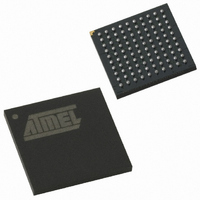AT89C51SND2C-7FTUL Atmel, AT89C51SND2C-7FTUL Datasheet - Page 204

AT89C51SND2C-7FTUL
Manufacturer Part Number
AT89C51SND2C-7FTUL
Description
IC 8051 MCU FLASH 64K MP3 100BGA
Manufacturer
Atmel
Series
89Cr
Datasheet
1.AT89C51SND2C-7FTUL.pdf
(242 pages)
Specifications of AT89C51SND2C-7FTUL
Core Processor
8051
Core Size
8-Bit
Speed
40MHz
Connectivity
I²C, IDE/ATAPI, MMC, SPI, UART/USART, USB
Peripherals
Audio, I²S, MP3, PCM, POR, WDT
Number Of I /o
32
Program Memory Size
64KB (64K x 8)
Program Memory Type
FLASH
Ram Size
2.25K x 8
Voltage - Supply (vcc/vdd)
2.7 V ~ 3.3 V
Data Converters
A/D 2x10b; D/A 2x20b
Oscillator Type
Internal
Operating Temperature
-40°C ~ 85°C
Package / Case
100-TFBGA
Data Bus Width
8 bit
Data Ram Size
2.25 KB
Interface Type
ATAPI, I2S, IDE, SPI, UART, USB
Maximum Clock Frequency
40 MHz
Number Of Programmable I/os
32
Number Of Timers
2
Maximum Operating Temperature
+ 85 C
Mounting Style
SMD/SMT
Minimum Operating Temperature
- 40 C
Lead Free Status / RoHS Status
Lead free / RoHS Compliant
Eeprom Size
-
Lead Free Status / Rohs Status
Details
Other names
AT89C51SND2C7FTUL
Available stocks
Company
Part Number
Manufacturer
Quantity
Price
Company:
Part Number:
AT89C51SND2C-7FTUL
Manufacturer:
ATMEL
Quantity:
4 371
- Current page: 204 of 242
- Download datasheet (3Mb)
23. Keyboard Interface
23.1
23.1.1
204
Description
AT8xC51SND2C/MP3B
Power Reduction Mode
The AT8xC51SND2C implement a keyboard interface allowing the connection of a keypad. It is
based on one input with programmable interrupt capability on both high or low level. This input
allows exit from idle and power down modes.
The keyboard interfaces with the C51 core through 2 special function registers: KBCON, the
keyboard control register (see Table 23-2); and KBSTA, the keyboard control and status register
(see Table 23-3).
An interrupt enable bit (EKB in IEN1 register) allows global enable or disable of the keyboard
interrupt (see Figure 23-1). As detailed in Figure 23-2 this keyboard input has the capability to
detect a programmable level according to KINL0 bit value in KBCON register. Level detection is
then reported in interrupt flag KINF0 in KBSTA register.
A keyboard interrupt is requested each time this flag is set. This flag can be masked by software
using KINM0 bits in KBCON register and is cleared by reading KBSTA register.
Figure 23-1. Keyboard Interface Block Diagram
Figure 23-2. Keyboard Input Circuitry
KIN0 inputs allow exit from idle and power-down modes as detailed in section “Power Manage-
ment”, page 47. To enable this feature, KPDE bit in KBSTA register must be set to logic 1.
Due to the asynchronous keypad detection in power down mode (all clocks are stopped), exit
may happen on parasitic key press. In this case, no key is detected and software must enter
power down again.
KIN0
KIN0
Input Circuitry
KBCON.4
KINL0
0
1
KBSTA.0
KINF0
IEN1.4
EKB
Keyboard Interface
Interrupt Request
KBCON.0
KINM0
4341H–MP3–10/07
Related parts for AT89C51SND2C-7FTUL
Image
Part Number
Description
Manufacturer
Datasheet
Request
R

Part Number:
Description:
DEV KIT FOR AVR/AVR32
Manufacturer:
Atmel
Datasheet:

Part Number:
Description:
INTERVAL AND WIPE/WASH WIPER CONTROL IC WITH DELAY
Manufacturer:
ATMEL Corporation
Datasheet:

Part Number:
Description:
Low-Voltage Voice-Switched IC for Hands-Free Operation
Manufacturer:
ATMEL Corporation
Datasheet:

Part Number:
Description:
MONOLITHIC INTEGRATED FEATUREPHONE CIRCUIT
Manufacturer:
ATMEL Corporation
Datasheet:

Part Number:
Description:
AM-FM Receiver IC U4255BM-M
Manufacturer:
ATMEL Corporation
Datasheet:

Part Number:
Description:
Monolithic Integrated Feature Phone Circuit
Manufacturer:
ATMEL Corporation
Datasheet:

Part Number:
Description:
Multistandard Video-IF and Quasi Parallel Sound Processing
Manufacturer:
ATMEL Corporation
Datasheet:

Part Number:
Description:
High-performance EE PLD
Manufacturer:
ATMEL Corporation
Datasheet:

Part Number:
Description:
8-bit Flash Microcontroller
Manufacturer:
ATMEL Corporation
Datasheet:

Part Number:
Description:
2-Wire Serial EEPROM
Manufacturer:
ATMEL Corporation
Datasheet:











